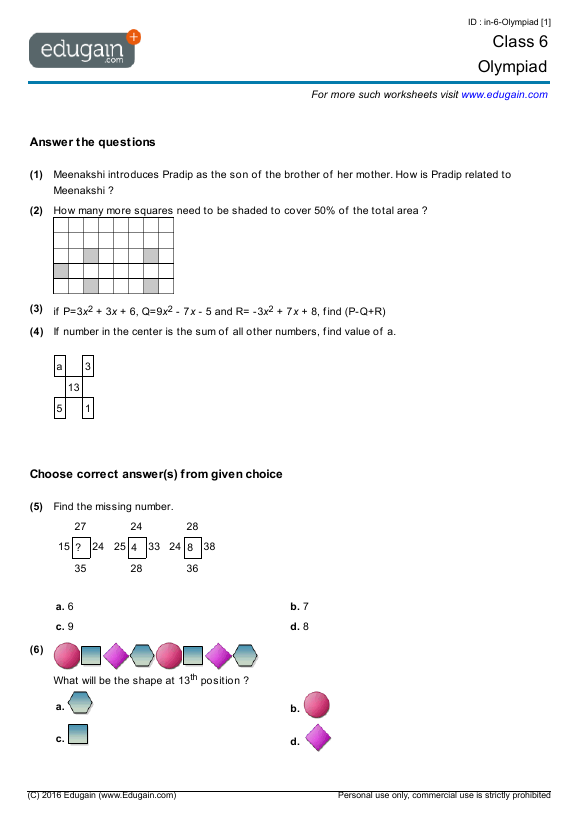
Get And Sign Australian Mathematics Competition Past Papers Pdf Form. For the Australian Mathematics Competition for the Westpac Awards, a Primary version for the Middle and Upper Primary divisions and a Secondary version for the Junior, Intermediate and Senior divisions Ideal for classroom practice and for coaching colleges, each pack consists of 10 identical copies of the Australian Mathematics Competition for a single year and division. Choose between Middle Primary, Upper Primary, Junior, Intermediate or Senior levels from the last five years. Each pack includes an answer key but n Seller: quickwave () %, Location: Craigieburn, VIC, Ships to: Worldwide, Item: AMC Upper Primary Y5 Y6 Papers. AMC (Australian Mathematics Competition) Past Papers with full answers for Year 5 and Year 6 (Upper Primary) Below will be provided as part of this set: 17 Papers with full answers - to 6 x Bonus Fully Worked Solutions – to Condition: Like
Textbooks Now for sale | Shop with Afterpay | eBay
The Australian Mathematics Competition is a mathematics competition run by the Australian Maths Trust for students from year 3 up to year 12 in Australiaand their equivalent grades in other countries.
Since its inception in in the Australian Capital Territorythe participation numbers have increased to around , with aroundbeing from outside Australia, making it the world's largest mathematics competition. The fore-runner of the competition, first held inwas open to students within the Australian Capital Territoryand attracted entries.
In and the outstanding entrants were awarded the Burroughs medal. In the medals were renamed the Westpac awards following a change to the name of the title sponsor Westpac Banking Corporation previously known as the Bank of New South Wales. Other sponsors since the inception of the competition have been the Canberra Mathematical Association and the University of Canberra australian mathematics competition past papers upper primary known as the Canberra College of Advanced Education.
The competition has since spread to countries such as New ZealandSingaporeaustralian mathematics competition past papers upper primary, FijiTaiwanChina and Malaysiawhich submit thousands of entries each. A French translation of the paper has been available since the current competition was established inwith Chinese translation being made available to Hong Kong Traditional Chinese Characters and Taiwan Traditional Chinese Characters students in Large print and braille versions are also available.
Inthe competition was expanded to allow two more divisions, one for year five and six students, and another for year three and four students. The competition paper consists of twenty-five multiple-choice questions and five integer questions, which are ordered in increasing difficulty.
Students record their personal details and mark their answers by pencil on a carbon-mark answer sheet, which is marked by computer. Sincean online option has been available to schools. The online competition has the same content as the paper version and results from both options are assessed together. There are five divisions in total: Senior for years 11 and 12Intermediate for years 9 and 10Junior for years 7 and 8australian mathematics competition past papers upper primary, Upper Primary for years 5 and 6 and Middle Primary for years 3 and 4.
Students are allowed 75 minutes australian mathematics competition past papers upper primary minutes for the two australian mathematics competition past papers upper primary papers to read and answer the questions. Calculators are not permitted for secondary-level entrants, but geometrical aids such as rulerscompassesprotractors and paper for working are permitted.
Primary-level entrants may use calculators and any aids normally found in a classroom. The original points scheme, which was in operation from inception untilconsisted of three groups of ten questions.
The first ten questions were worth three marks each, the next ten four marks each, and the last ten five marks each. Students were deducted a quarter of the marks for a given question if they answered incorrectly, so that a student randomly guessing the answers would gain no numerical benefit on statistical average. Students started with 30 marks, so that a student who answered all questions incorrectly would record a total score of zero, while one who answered all questions correctly would record a score of Inthe format was changed so that no penalties were incurred for incorrect answers to the first twenty questions, and for each of the last ten questions, a correct answer gave eight marks, no answer gave three marks, and no marks were given for an incorrect answer; the total score remained the same at Inthe format was changed once more.
This time the first ten questions are still worth three marks each and the next ten are still worth four marks each, however the last ten are now once again worth 5 marks each, australian mathematics competition past papers upper primary.
To make it harder to guess the most difficult questions, the last 5 questions required integer answers between 0 and inclusive. The total score possible was thus reduced to It has since been changed yet again. The first 25 questions have remained with the same mark allocation, however the last 5 questions have been altered. Although still requiring integer answers between 0 andthe mark allocation has been changed to 6 marks for Q26, 7 marks for Q27, 8 marks for Q28, 9 marks for Q29 and 10 marks for Q30, bringing the total marks to The competition is supervised by staff of the individual educational institutions, and the Australian Maths Trust reserves the right to conduct re-examinations in order to preserve the integrity of the competition, australian mathematics competition past papers upper primary, if it believes that students have not attempted the paper under sufficiently stringent conditions.
There is no official declared syllabus which determines the scope of the problems presented to the students, australian mathematics competition past papers upper primary. However, all problems can be solved without the use of calculus. Despite the name of the competition, students are allocated awards for their performance relative to other students in their region, of the same year level.
For Australian students, this means their State or Territory, and for other students, their country. Although the personal data such as date of birth and gender are collected, this is not used in the percentile ranking, which is only determined by the raw score, australian mathematics competition past papers upper primary. The award scheme is as such. Students who have won a prize may also receive a medal if they are determined to have performed outstandingly well with respect to their region and the competition as a whole.
All students receive a certificate, and prizewinners are awarded an additional monetary sum or book voucher. Students who achieve the maximum score are awarded the BH Neumann certificate.
Fromthis award has been renamed the Peter O'Halloran Certificate in honour of the foundation Executive Director of the Trust. Ina record 10 students in Australia, and 23 in Singapore achieved the maximum attainable score. A re-examination was carried out in order to determine the Singaporean medallists. All students receive an analysis sheet along with their certificate, which records their answers for each question, along with the correct answers.
The questions are divided into four categories: arithmetic, algebra, geometry and problem solving, and the number of questions that the student answered correctly for each category is listed along with the regional mean.
Every school receives a more comprehensive analysis, with a complete record of answers given by all students, as well as the percentage of students choosing any given answer for a given question, and a comparison to the percentage of students choosing any given answer for a given question in the whole region.
Schools also receive analysis of their students by mathematical topic, compared to the entire region. At least three students have won medals on all six of their opportunities australian mathematics competition past papers upper primary participate: [2]. Shane Booth, Wanganui Park High School, SheppartonVictoria was the first to win five consecutive medals — Ivan Guo, Sydney Boys High SchoolNew South Wales was the first person to win three consecutive BH Neumann certificates, which are only awarded to those who achieve a perfect score.
From Wikipedia, the free encyclopedia. Archived from the original on Retrieved CS1 maint: discouraged parameter link. This article relies too much on references to primary sources. Please improve this by adding secondary or tertiary sources.
December Learn how and when to remove this template message. Categories : Mathematics competitions Education competitions in Australia Recurring events established in Hidden categories: CS1 maint: discouraged parameter All articles with unsourced statements Articles with unsourced statements from July Articles lacking reliable references from December All articles lacking reliable references.
Navigation menu Personal tools Not logged in Talk Contributions Create account Log in. Namespaces Article Talk. Views Read Edit View history. Main page Contents Current events Random article About Wikipedia Contact us Donate.
Help Learn to edit Community portal Recent changes Upload file. What links here Related changes Upload file Special pages Permanent link Page information Cite this page Wikidata item. Download as PDF Printable version. فارسی 中文 Edit links.
AMC Practice Intermediate 2013 Q 20
, time: 2:42AMC UPPER PRIMARY Year / Grade 5 and 6 Papers, Answers and Solutions - $ | PicClick AU

The AMC is suitable for students from lower primary to upper secondary. Entrants in years 3–6 are asked to solve 30 problems in 60 minutes, while those in years 7–12 have 75 minutes to solve more complex problems. The problems get more challenging as the competition progresses, so students of all abilities will be challenged and inspired Upper Primary Junior Intermediate Senior For Practice - OUCC - Round 1. Upper Primary (years 5 and 6) Junior (years 7 and 8) Intermediate (years 9 and 10) Senior (years 11 and 12) 5/27/ · We are the Mathematics department of Sri Lankan School Muscat. Mathematics embodies the spirit of the liberal arts: mathematics is an art, a pure science, a language and an analytical tool for the natural and social sciences, a means of exploring philosophical questions, and a beautiful edifice that is a tribute to human creativity

No comments:
Post a Comment